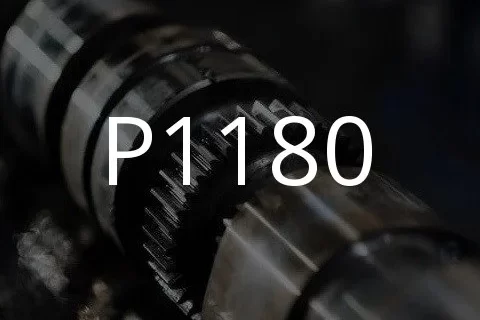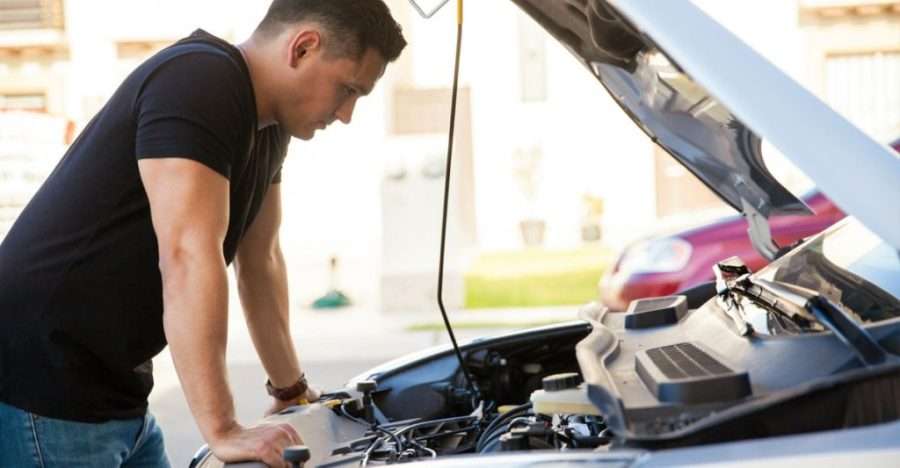
P1180 (Volkswagen, Audi, Skoda, Seat) Heated oxygen sensor (HO2S) 1, bank 1, pump current - short circuit to positive
Content
P1180 – OBD-II Trouble Code Technical Description
Trouble code P1180 indicates a short to positive in the heated oxygen sensor (HO2S) 1 bank 1 circuit, which measures pump current in Volkswagen, Audi, Skoda, Seat vehicles.
What does the fault code mean P1180?
Trouble code P1180 indicates a problem with the vehicle's heated oxygen sensor (HO2S) 1, bank 1. This sensor is designed to measure the oxygen level in the exhaust gases to ensure optimal fuel and air mixing in the fuel injection system. A short to positive in the sensor circuit indicates that the sensor wiring has a problem that causes it to be shorted to positive. Because the heated oxygen sensor is important to the correct operation of the engine management system, a malfunctioning heated oxygen sensor can result in improper fuel mixture adjustment, which can ultimately affect engine operation, performance, and fuel consumption.

What are the symptoms of a fault code? P1180?
Several possible reasons for the P1180 trouble code:
- Damaged wiring: Damage to the wiring connecting the heated oxygen sensor to the vehicle's electrical system may result in a short circuit to positive. This may be caused by broken, broken or damaged wires.
- Contact corrosion: Corrosion on connector pins or wires can create a low resistance path to positive voltage, resulting in a short to positive.
- Defective oxygen sensor: The heated oxygen sensor itself may be faulty, causing a short to positive in its circuit.
- Problems with the electronic control unit (ECU): Faults in the ECU, such as an internal short circuit or software errors, can also cause the P1180 code to appear.
- Mechanical damage: Physical damage to the wiring, connectors, or the sensor itself, possibly caused by an accident or mechanical stress, can result in a short circuit to positive.
- Incorrect installation or repair: Improper installation or repair of the heated oxygen sensor or wiring may result in incorrect connections and a short to positive.
To accurately determine the cause of the P1180 trouble code, it is recommended that you conduct a detailed diagnosis using specialized equipment or contact a qualified auto mechanic.
How to diagnose a fault code P1180?
The following approach is recommended to diagnose DTC P1180:
- Reading the error code: Use the OBD-II diagnostic scanner to read the P1180 trouble code from the Electronic Engine Control Unit (ECU). This will help determine what exactly the problem is with the heated oxygen sensor.
- Checking wiring and connectors: Carefully inspect the wiring and connectors connecting the heated oxygen sensor to the ECU. Pay attention to possible damage, breaks, corrosion or mismatched contacts. If necessary, carefully check the electrical connections.
- Checking the Heated Oxygen Sensor: Use a multimeter to check the resistance and functionality of the heated oxygen sensor. Also check the sensor output to ensure it meets manufacturer's standards.
- Checking the electronic control unit (ECU): Diagnose the ECU for errors or malfunctions that could cause the P1180 code to appear. Also check the quality of communication between the ECU and the sensor.
- Additional tests: Perform additional tests, such as an exhaust gas test or testing other engine management system components, to rule out other potential causes of the problem.
- Checking the installation and fastening of the sensor: Check the installation and fastening of the heated oxygen sensor. Make sure it is properly installed and secured according to the manufacturer's recommendations.
- Consultation with a qualified specialist: If there are any uncertainties or lack of experience, it is best to contact a qualified auto mechanic or service center for a more detailed diagnosis and troubleshooting of the problem.
After diagnosing and identifying the cause of the P1180 code, perform the necessary repairs according to the manufacturer's recommendations. If you do not have confidence in your skills, it is better to contact a qualified auto mechanic for diagnosis.
Diagnostic errors
When diagnosing DTC P1180, the following errors may occur:
- Skipping inspection of wiring and connectors: Failure to pay sufficient attention to the condition of the wiring and connectors connecting the heated oxygen sensor to the ECU may result in missing damage, corrosion, or malfunctions that could be the source of the problem.
- Misinterpretation of data: Misinterpretation of test results on the heated oxygen sensor or other system components may lead to incorrect conclusions about the cause of the P1180 code and incorrect repairs.
- Faulty diagnostic equipment: The use of faulty or uncalibrated diagnostic equipment may result in incorrect error detection or misinterpretation.
- Skipping Additional Tests: Not performing all the necessary additional tests, such as checking the exhaust gases or checking the operation of other systems, may result in missing hidden problems associated with the P1180 code.
- Insufficient experience or knowledge: Lack of sufficient experience or knowledge in the field of automotive repair may lead to incorrect diagnosis and repair of the problem.
- Component problems: Faults in other components of the engine management system or the vehicle's electronic system may result in misdiagnosis and replacement of faulty parts.
To avoid these mistakes, it is important to conduct a comprehensive diagnosis using the correct equipment and techniques, as well as have sufficient experience and knowledge in the field of automotive repair.
How serious is the fault code? P1180?
Trouble code P1180 indicates a problem with the vehicle's heated oxygen sensor (HO2S) 1, bank 1, which can have a serious impact on its operation, several factors that determine the severity of this error:
- Influence on engine performance: The heated oxygen sensor plays a key role in regulating the mixture of fuel and air required for combustion in the engine. A faulty sensor can result in improper fuel delivery, which can affect engine performance, stability and efficiency.
- Increased emissions of harmful substances: Improper mixing of fuel and air caused by a faulty oxygen sensor can lead to increased emissions of harmful substances such as nitrogen oxides (NOx) and hydrocarbons, which can have negative environmental and health impacts.
- Loss of power and increased fuel consumption: Improper fuel and air mixing can also result in loss of engine power and increased fuel consumption, which negatively impacts vehicle operating costs and satisfaction.
- Inability to pass technical inspection: In some regions, the P1180 trouble code may cause you to fail a vehicle inspection or inspection because the vehicle may be deemed to be non-emission compliant.
With the above in mind, DTC P1180 should be considered a serious problem that requires immediate attention and diagnosis. Faulty components must be repaired or replaced to restore normal engine operation and meet environmental standards.
What repair will help eliminate the code? P1180?
Resolving the P1180 trouble code depends on the specific cause of the error, there are several possible repair steps that may help:
- Heated Oxygen Sensor (HO2S) Replacement: If the sensor is faulty, it should be replaced with a new one compatible with your vehicle. When replacing, ensure that the new sensor meets the manufacturer's specifications and is installed correctly.
- Repair or replacement of wiring and connectors: Check the condition of the wiring and connectors connecting the oxygen sensor to the vehicle electrical system. If damage, corrosion or broken wires are found, repair or replace them.
- Checking and servicing the electronic control unit (ECU): Diagnose the ECU for errors or malfunctions that may affect the operation of the oxygen sensor. If necessary, perform firmware or update the ECU software.
- Diagnostics and maintenance of other systems: Check the operation of other engine management system components such as fuel injection, ignition and exhaust systems to rule out possible problems affecting the performance of the oxygen sensor.
- Clearing error memory and testing: After repair work, clear the ECU error memory using a diagnostic scanner. Take a test drive to check the system and make sure the P1180 code is no longer active.
Each case requires an individual approach to diagnosis and repair. It is important to pay attention to all possible causes of the P1180 error code and carry out repairs according to the manufacturer's recommendations and taking into account the specifications of your vehicle. If you do not have the necessary experience or equipment, it is better to contact a qualified auto mechanic or an authorized service center.

